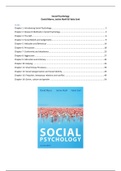Samenvatting
VOLLEDIGE SAMENVATTING 'Social Psychology' - Myers, Abell en Sani
- Instelling
- Tilburg University (UVT)
- Boek
- Social Psychology
Een volledige samenvatting van alle hoofdstukken van 'Social Psychology' van Myers, Abell en Sani, met veel voorbeelden en afbeeldingen.
[Meer zien]















